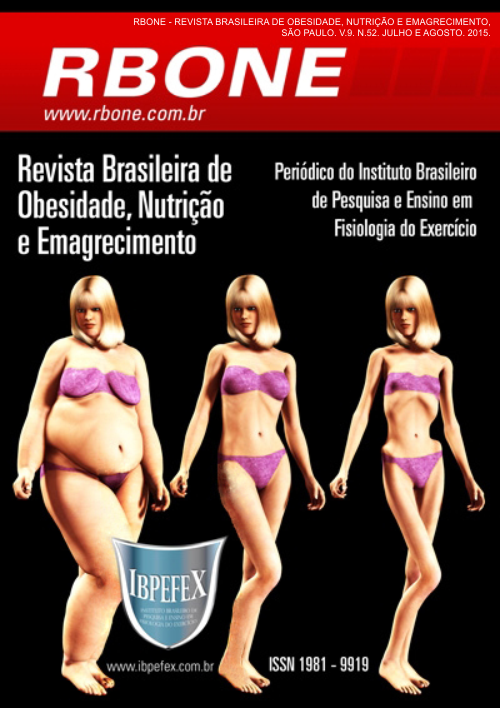Strength training effects on the percentage ofbody fat in adults
Abstract
The sedentary lifestyle associated with industrialized with high-calorie foods has caused obesity worldwide. One of the methods for weight loss and control of non-pharmacological body weight is regular and targeted practice of physicalactivity. The aim of the present study the effect of a training program on weight, body composition and cardiovascular risk factors was analyzed. 67 volunteers, 20 men, 30.0±6.9 years, 95.5±18,7Kg, 31.7±4.8kg/m2and 29.9±8.2%F and 47 women: 34.0±7,5 years, 80.6±16,1Kg, 31.3±6.6 kg/m2and 36.5±8.4%F matriculate in the Academy Acqua Therapy in Guaxupé / MG. Participated in a bodybuilding program lasting six months, where three anthropometric assessments were performed which were measured: body weight, BMI, %BF, waist circumference, hip and abdomen. Significant reductions in all variables when compared to first assessment (pre-training) with the second and third evaluations (respectively, third months and sixth months of training). Significant reductions compared the results between the second and third assessments also occurred in all studied parameters, except for BMI and% BF. The WHR and waist circumference showed increases in the normal range in both genders between the first and second assessments, but notbetween the second and third assessments. It wasconclude that effective participation in a program of well targeted strength training is an important mechanism for the loss or weight management.
References
-Alahmadi, M.A. High-intensity Interval Training andObesity. J Nov Physiother. Vol. 4. Núm. 3. 2014.
-American College of Sports Medicine. Appropriate physical activity intervention strategies for weight loss and prevention of weight regain for adults. Med. Sci. Sports Exerc. Vol. 33. Núm. 12. p. 2145-2156. 2001.
-American College of Sports Medicine. Position stand: progression models in resistance training for health adults. In: Medicine & Science in Sports & Exercise. Vol. 34. Núm. 2. p. 364-380. 2002.
-Balsamo, S.; Simão, R. Treinamento de Força: para Osteoporose, Fibromialgia, Diabetes Tipo II, Artrite Reumatóide e Envelhecimento. São Paulo. Phorte. 2005.
-Borsheim, E.; Bahr, R. Effect of Exercise Intensity, Duration and Mode on Post-Exercise Oxygen Consumption. Sports Medicine. Vol. 33. Núm.14. p. 1037-1060. 2003.
-Domingues Filho, L. A. Obesidade e atividade física. Jundiaí. Fontoura. 2000.
-Fleck, S.J.; Kraemer, W.J. Fundamentos do Treinamento de Força Muscular: Princípios Básicos do Treinamento de Força Muscular. Artmed. 2006.
-Guedes, D.P.; Guedes, J.P. Controle de Peso Corporal e Atividade Física e Nutrição. Londrina. 1998.
-Heyward, V.H.; Stolarczyk, L.M. Avaliação da composição corporal aplicada. Manole. 2000.
-Laforgia, J.; Withers, R.T.; Shipp, N.J.; Gore, C.J. Comparison of energy expenditure elevations after submaximal and supramaximal running. J Appl Physiol. Vol. 82. p. 661-666.1997.
-Lopes, M.H. Exercícios de Força em Obesos Promove o Emagrecimento. TCC. UGF. 2008.
-Ormsbee, M. J.; Thyfault, J. P.; Johnson, E. A.; Kraus, R. M.; Choi, M. D.; Hickner, R. C. Fat metabolismo and acute resistance exercise in trained men. J Appl Physiol. Vol. 102. p. 1767-1772. 2007.
-Pesquisa de Orçamento Familiar 2008 -2009. Despesas, Rendimentos e Condições de Vida. Instituto Brasileiro de Geografia e Estatística. 2010.
-Schuenke, M.D.; Mikat, R.P.; McBride, J.M. Effect of an acute period of resistance Exercise on excess post-exercise oxygen consumption: implications for body mass management. Eur. J Appl Physiol. Vol. 86. p. 411-417. 2002.
-Williams, M.H. Nutrição para a Saúde, Condicionamento Físico & Desempenho Esportivo. Manole. 2002.
-Wilmore, J. H.; Stanforth, F. R.; Hudspeth, L. A.; Gagnon, J.; Daw, E. W.; Leon, A. S.; Skinner, J. S.; Bouchard, C. Alterations in resting metabolic rate as a consequence of 20 wk of endurance training: the Heritage Family Study. Am J Clin Nutr. p. 68:66-71. 1998.
Authors who publish in this journal agree to the following terms:
- Authors retain the copyright and grant the journal the right of first publication, with work simultaneously licensed under the Creative Commons Attribution License BY-NC which allows the sharing of the work with acknowledgment of the authorship of the work and initial publication in this journal.
- Authors are authorized to enter into additional contracts separately for non-exclusive distribution of the version of the work published in this journal (eg, publishing in institutional repository or book chapter), with acknowledgment of authorship and initial publication in this journal.
- Authors are allowed and encouraged to post and distribute their work online (eg, in institutional repositories or on their personal page) at any point before or during the editorial process, as this can bring about productive change as well as increase impact and impact. citation of published work (See The Effect of Free Access).






